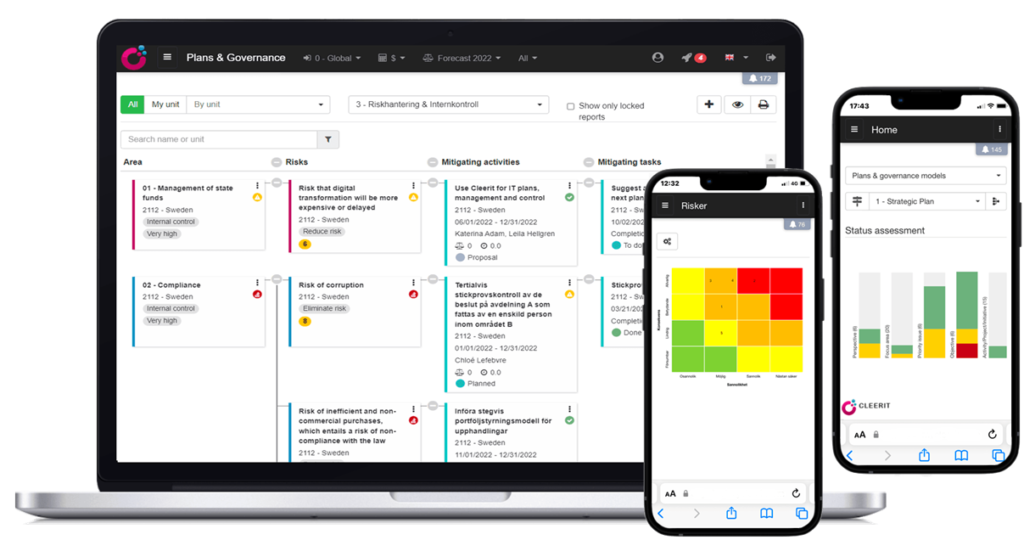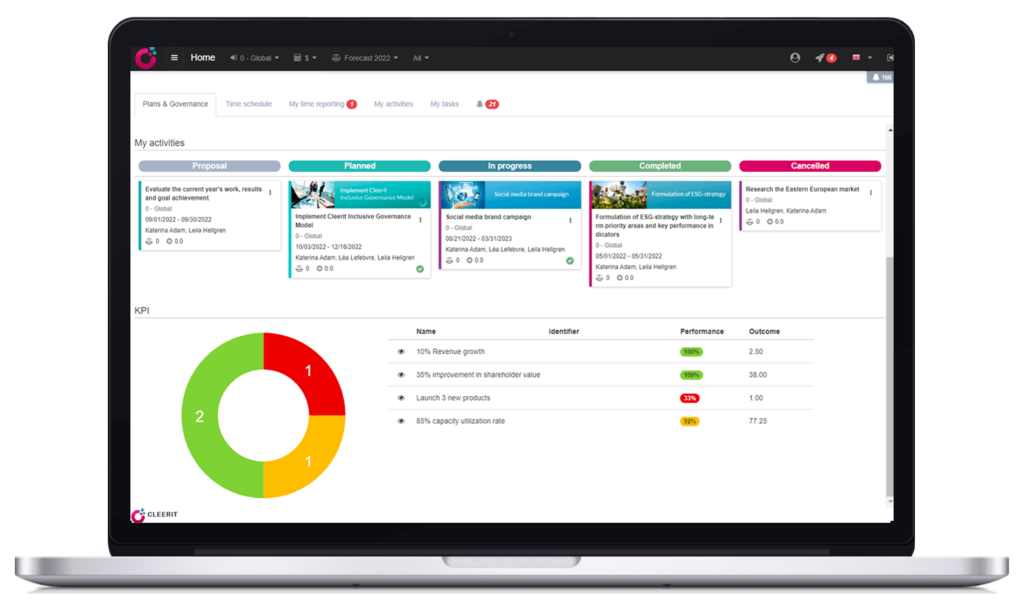Identify, analyze, assess and mitigate risks, ensure regulatory compliance, minimize the effects of unwanted contingencies and obstacles
Be prepared when unforeseen situations arise
- Identify and manage risks that may prevent you from reaching your goals or comply with regulations
- Reduce risks that may prevent you from carrying out operations and projects effectively
- Manage organizational & ESG risks, regulatory compliance and project risks in the same solution
- Visualize risks in a matrix and in governance models adapted to your needs
- Assess and evaluate risks and material topics, and monitor development over time
- Allocate responsibilities and create action plans to prevent or mitigate the negative consequences of risks
- Familiarize yourself with the outside world and future decisions that could affect your organization
- Simplify collaboration and communication across the organization
With Cleerit risk management is no longer time-consuming or complicated. You secure your operations, regulatory compliance, continuous quality improvement and sustainable strategic success.



Don’t be unprepared, prevent difficulties with Cleerit!
More about risks, compliance and internal governance & control
Why is effective risk management important for my organization?
Risks and unforeseen adverse events can prevent you from achieving your goals or negatively impact your operations and organization. An important step in a planning process is therefore to effectively identify your risks, to be able to prevent them before they occur or mitigate their consequences if they occur.
In other words, effective risk management makes it easier to achieve your goals and keep costs down.
With the help of a well-thought-out risk analysis, your organization gets an overall picture of its most important vulnerabilities and challenges, and is prepared for situations that may arise. These can be everything from equipment deficiencies or technical problems, to theft, personnel illness, supply disruptions, insufficient financing, natural disasters and crisis situations of various kinds.
The risk analysis can also mean getting acquainted with how external changes and the agenda for political decisions can affect operations, which is important in order to be able to act proactively and manage these in the best way.
Effective risk management thus secures both operations and continuous quality improvement, as well as having a positive impact on the organization’s goodwill and environmental profile. In collaboration with other actors, risk management also lays the foundation for preventive measures that are needed to achieve and maintain a safe society.
But it is not uncommon for risk analyzes to be perceived as difficult and time-consuming, and therefore not be given the priority they should have. As a result, many suffer from unexpected negative surprises unnecessarily. One reason may be a lack of structured and inclusive system support for risk analysis and management.
When you work with Cleerit’s inclusive risk management models, risk analysis is easy and transparent, and you have a clear, real-time and well-structured overview of identified risks, probabilities, impacts, mitigating controls and risk reducing action plans.
With Cleerit, risk management will no longer be time-consuming and complicated. You secure both your operations, continuous quality improvement and regulatory compliance.
Cleerit supports the 4 steps in risk analysis
The purpose of a risk analysis is to identify, analyze and assess risks, understand the underlying causes and implement controls and measures to eliminate or reduce the risks, or mitigate the consequences of adverse events should they occur.
The risk analysis is a process that can be divided into four steps: examine – assess – mitigate – control:
- Examine – Start by gathering information and identifying potential risks.
- Assess – Evaluate the identified risks based on how likely and serious they are and decide how you want to handle them.
- Mitigate – Define action plans and control measures to manage the risks, allocate responsibility and ressources and monitor execution.
- Control – Ensure that measures have been taken and evaluate whether these have had the desired effect.
Identify risks and assess them based on how serious they are
Identification of risks, contingencies or adverse events is one of the most important steps in carrying out a risk analysis, as the content of the analysis is then defined. Risks that are not identified are also not analyzed, which in turn leads them to be undervalued and the need for contingency planning to be underestimated or, in the worst case, completely overlooked.
When the risks have been identified, the next step is to evaluate them based on how serious the impact, the consequences, would be should they occur. Ask yourself:
- What would these events mean for our organization and operations?
- What resources, assets, goodwill would we lose in such an event?
Then make an estimate of how likely it is that the risks will occur. The impact and probability assessment forms the basis for calculating the risk value.
With Cleerit’s built-in impact and probability assessment, the risk value calculation is automated and monitored over time. The higher the risk value, the more important it is that the risk is mitigated.
Last but not least, create an action plan to mitigate the risks
The next step in a structured risk management process is to develop and implement an action plan with clearly identified resource-based activities and control measures, in order to manage the risks that have been identified, and in particular risks with a high risk value.
With the help of the risk value, you can decide which risks you should prioritize and try to prevent them as far as possible, or preferably eliminate them completely. If the risk cannot be completely prevented, you can think about how you can reduce the adverse effect should it occur.
The action plan should ideally include preventive measures that minimize the risk of high-risk situations arising. The goal is to eliminate risks, reduce the probability of a risk event occurring and reduce the impact of the risks on the organization’s ultimate goals.
It is also important to understand the type of resources required to manage the identified risks.
Risks that are accepted and monitored should also be included in your action plan. Before deciding to accept a risk, i.e. not to take any further action, it is important to make an impact assessment to analyze the consequences of such a decision. Although it is not always possible to do anything to prevent the risk, you can be prepared with the help of a contingency plan that simplifies the management of adverse effects.
Once the measures have been identified, responsibility should be allocated throughout the organization. It is important that there is a clear and shared understanding of what needs to be done and why, as well as who does what, when, how and at what cost.
The measures should then be planned, implemented, monitored, and adjusted if necessary, in a structured action plan. With the activity planning functions in Cleerit, you perform these tasks easily and efficiently.
Read more
Read more about Internal control, governance, risk management and compliance (GRC) in Cleerit.
Read more about how effective and relevant reporting can help you turn your strategies into reality.